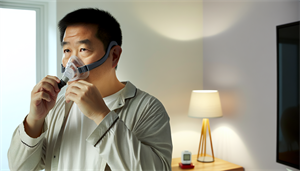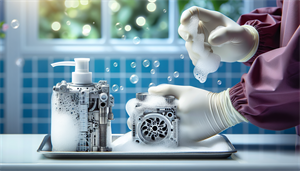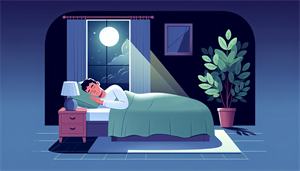Are sleep apnea machines safe? This pressing concern for sleep apnea patients gets a direct answer here: yes, they are, when certain guidelines are followed.
Shedding light on the measures that maximize safety and the simple precautions that can prevent complications, this article acts as a roadmap to confident CPAP use.
We’ll navigate through safety protocols, risk factors, and maintenance advice, equipping you with knowledge for peace of mind.
Key Takeaways
-
CPAP machines are essential for managing sleep apnea by keeping airways open during sleep, preventing complications, and improving survival rates, but must be used correctly and maintained for safety.
-
While CPAP therapy is considered safe by the FDA, users must be mindful of managing common side effects using strategies like humidifiers and ensure replacements of CPAP parts as needed to maintain hygiene and device performance.
-
Alternative treatments such as oral appliances, positional therapy, and lifestyle changes are options for sleep apnea patients who struggle with CPAP therapy, though CPAP remains a highly effective and safe treatment when used properly.
Understanding CPAP: The Lifesaver for Obstructive Sleep Apnea

Sleep apnea, including central sleep apnea, is a serious sleep disorder, characterized by breathing interruptions during sleep, snoring, and daytime sleepiness. CPAP therapy has emerged as a medical marvel, addressing these issues by delivering continuous positive airway pressure to maintain open airways during sleep. Studies highlight that CPAP machines are highly effective in treating sleep apnea, breathing new life into the nights of those suffering from this condition.
Preventing complications of obstructive sleep apnea, such as heart problems and excessive daytime sleepiness, necessitates adherence to CPAP treatment, thereby enhancing survival rates. CPAP therapy aims to alleviate common symptoms of sleep apnea, including:
-
Snoring or gasping for air
-
Issues with memory
-
Concentration
-
Daytime sleepiness
The Role of CPAP in Sleep Apnea Treatment
Maintaining the openness of the upper airway during sleep, a key factor in managing sleep apnea, is the primary function of a CPAP machine. The CPAP pressure is adjusted according to the user’s needs to ensure effective treatment. The recommended treatment for severe sleep apnea typically includes high pressure CPAP therapy, along with lifestyle changes and advice to avoid sleeping on your back.
So, CPAP machines are not just another medical device; they are lifelines for those struggling with sleep apnea. They ensure night-time breathing is not interrupted, promising a good night’s sleep and a better quality of life.
How CPAP Machines Work
The operational principle of a CPAP machine involves delivering a continuous stream of pressurized air, or air pressure, through a mask into the airway to maintain its openness, thereby mitigating breathing difficulties and facilitating the elimination of carbon dioxide while enhancing oxygen levels in the lungs. The machine consists of a motor that draws in room air to pressurize it, a hose that channels the air, and a mask that delivers the pressurized air to the user’s airway, thereby supporting consistent breathing throughout the night.
Varieties of CPAP machines cater to individual needs. For instance, APAP machines adapt pressure according to the user’s breathing patterns, and BiPAP machines provide two pressure levels for inhalation and exhalation. It’s like having a personalized sleep specialist at your side, ensuring that you breathe easy while you dream away.
Assessing the Safety Profile of CPAP Devices

While CPAP machines have proven to be effective, questions about their safety often arise. Safety of CPAP therapy can be ensured by:
-
Using the machine correctly
-
Maintaining cleanliness of the equipment
-
Replacing it when necessary
-
Promptly addressing any signs of problems
Research indicates that the advantages of using CPAP machines outweigh any potential risks, and it is important to note that no FDA-approved CPAP machines have been discovered to cause life-threatening complications when used in the correct manner.
Therefore, it is recommended that individuals consult their healthcare provider for more personalized advice on the safety of CPAP therapy. The risk linked to CPAP machines is deemed to be minimal, suggesting that they are generally safe when used as instructed.
FDA Oversight and CPAP Certification
The role of the Food and Drug Administration (FDA) in the safety of CPAP machines cannot be undermined. The FDA oversees the sale of CPAP machines and other medical devices in the United States. CPAP devices are required to adhere to the special controls specified by the FDA for class II medical devices to achieve FDA certification.
Before marketing their devices, CPAP manufacturers must submit a Premarket Approval (PMA) application to the FDA and obtain approval. The approval is contingent upon the FDA’s assessment of the device’s safety and effectiveness. However, recalls do occur. For instance, in June 2021, Philips initiated a recall of specific CPAP machines due to potential health hazards.
Health Risks vs. Benefits of CPAP Therapy
With significant health benefits, CPAP therapy can enhance sleep quality and overall well-being. CPAP therapy can alleviate symptoms of sleep apnea, including snoring and daytime sleepiness, as well as enhance morning headaches and oxygen saturation. However, like any other treatment, CPAP therapy may have side effects. Potential health hazards include the risk of untreated sinus infection, mouth, eye, and respiratory tract infections. Prolonged use may also result in issues such as facial development problems in children, dental concerns, skin irritations, nasal congestion, claustrophobia, facial pressure sores, persistent dry or runny nose, chronic congestion, and throat weakness.
Debunking Myths: Can CPAP Machines Cause Harm?
Prevalent misconceptions about CPAP machines often deter people from considering this effective sleep apnea treatment. Many believe that the treatment is uncomfortable, that CPAP is solely for individuals who snore or only for older people, and that CPAP machines are bulky and loud.
In reality, CPAP machines are highly unlikely to result in serious health issues. They can potentially cause harm if they are not adequately maintained or if they are defective.
Clarifying Misunderstandings About Forced Air
A common misconception revolves around the discomfort and usability challenges that people associate with the forced air from CPAP machines. Many users eventually find them to be advantageous in the treatment of sleep apnea once they acclimate to their use. The forced air from CPAP machines is generally considered safe for lung health. On occasion, users may encounter discomfort or a burning sensation in the lungs, which can often be alleviated by maintaining proper device hygiene and maintenance.
It is important to note that a defective device can pose harm, underscoring the significance of using a properly functioning machine.
Common Side Effects of CPAP Use and Mitigation Strategies

Despite the proven benefits of CPAP therapy, it does have a set of common side effects. These include nasal congestion, a runny nose, dry nose, dry mouth, and dry eyes, often stemming from the dry air flow generated by the machine. To address these side effects, individuals can use a heated humidifier connected to their CPAP machine, modify the humidification level, and apply a nasal saline spray before bedtime.
Moreover, the use of a chinstrap can aid in preventing dry mouth by ensuring the mouth remains closed.
Addressing Nasal Congestion and Dryness
Nasal congestion and dryness in CPAP users can be attributed to the irritant nature of CPAP air, which has the potential to dry out the nasal passages and cause bleeding. Furthermore, the flow of dry air from the CPAP machine can result in nasal congestion.
A humidifier can add moisture to the airflow from the CPAP machine, decreasing dryness and discomfort in the nasal passages and throat. Using a nasal pillow mask can also help in this situation. Saline spray helps by hydrating the nasal passages and reducing dry nasal tissue, which can aid in reducing nasal congestion and dryness for CPAP users.
Preventing Skin Irritation
The use of CPAP may lead to skin irritation, rashes, acne, and sores. To address these side effects, individuals may need to experiment with various mask styles or sizes, incorporate cushioning for enhanced comfort, consider switching to a different mask style, or adjust the sizing of their current mask.
CPAP masks should be meticulously cleaned by:
-
Wiping down or washing the cushion with mild soap and water after each use.
-
Disassembling the entire mask and components.
-
Wiping down the external surfaces to prevent bacteria accumulation.
Navigating CPAP Machine Maintenance and Hygiene

The importance of maintaining CPAP machines equals that of their use. Regularly cleaning CPAP equipment is essential in order to uphold hygiene, prevent infections, and guarantee the device functions at its peak performance levels. CPAP manufacturers advise that the mask, tubing, and humidifier chamber should be washed at least once a week, with daily cleaning preferred after each use.
It is recommended to use mild, unscented soap or white vinegar for cleaning the humidifier tank.
Cleaning Routines for CPAP Equipment
Frequent cleaning of CPAP equipment is essential to mitigate the risk of health issues such as pneumonitis, difficulty breathing, cough, fatigue, skin infections, and rashes. Considered safe for use on CPAP equipment are:
-
Mask wipes
-
Soaps
-
Sprays
-
Tube brushes
-
Disinfectants
-
UV sanitizers
It is recommended to use baby soaps, soft hand-washes, mild shampoos, natural dish soap, and special CPAP soap to ensure effective cleaning without causing damage to the equipment.
When to Replace CPAP Accessories
Achieving optimal treatment outcomes necessitates regular replacement of CPAP accessories, such as cpap mask parts and nasal mask components. Research indicates that replacing mask parts can result in substantial enhancement in the quality of treatment and improved usage of PAP therapy.
It is advised to replace CPAP masks every 3 months, and CPAP tubing should also be replaced every 3 months, although the frequency of replacement may vary based on usage and wear.
Alternative Therapies for Treating Central and Obstructive Sleep Apnea

Alternative treatments to treat sleep apnea are available for those who struggle to adapt to CPAP therapy. These include oral appliance therapy, positional therapy, surgery, and lifestyle changes.
Positional therapy for sleep apnea is a behavioral strategy that entails the practice of sleeping on one’s side or stomach, aimed at diminishing apnea events and enhancing respiratory function.
Oral Appliances and Positional Therapy
Oral appliances for sleep apnea can potentially alleviate symptoms such as irritability, difficulties in concentration, and daytime exhaustion. The efficacy of oral appliances in addressing sleep apnea varies, with an overall success rate of 52% and rates ranging from 25-63% for patients with mild, moderate, or severe OSA.
Lifestyle Modifications
Managing both central and obstructive sleep apnea can be greatly influenced by lifestyle modifications. Some beneficial changes to consider include:
-
Weight loss
-
Heightened physical activity
-
Cessation of smoking and alcohol consumption
-
Avoidance of specific medications
-
Modification of sleep patterns
These lifestyle modifications can be advantageous for managing sleep apnea.
Weight loss also leads to a reduction of fat in the abdomen and tongue, as well as a decrease in the size of soft tissues in the upper airway, contributing to clearer airways during sleep.
Expert Perspectives on CPAP Therapy
Healthcare professionals deem CPAP therapy as a safe and effective treatment for sleep apnea, yielding both short- and long-term benefits. The correct utilization and upkeep of CPAP machines are crucial for mitigating breathing disruptions and daytime side effects of sleep apnea.
Summary
In conclusion, CPAP therapy has emerged as an effective treatment for sleep apnea. While there are misconceptions about its safety and comfort, the benefits of CPAP therapy far outweigh the potential side effects. Proper maintenance of the equipment and adherence to treatment can ensure optimal results.
For those who find it challenging to adapt to CPAP therapy, alternative treatments are available. The key is to find a treatment that suits individual needs and lifestyle, ensuring a good night’s sleep and improved quality of life.
Frequently Asked Questions
Is there any danger in using a CPAP machine?
Yes, there can be potential issues such as nasal congestion, runny nose, dry nose, nosebleeds, and crusting when using a CPAP machine, especially in cold or low humidity environments. These factors can pose risks to CPAP users.
What are the long-term effects of using a CPAP machine?
Long-term use of a CPAP machine can lead to issues such as constant dry or runny nose, congestion, and weakened throat muscles, and in some cases, a defective machine can cause long-term damage to the lungs.
Related health topics?
Explore a range of health topics to find information that may be relevant to your needs.
How effective are CPAP machines in treating sleep apnea?
CPAP machines are highly effective in treating sleep apnea, improving symptoms and enhancing overall quality of life. They are known to significantly reduce snoring and daytime sleepiness.
How often should CPAP equipment be cleaned?
You should clean your CPAP mask daily and other components like tubing and humidifier chamber at least once a week to maintain hygiene and functionality. Regular cleaning helps prevent the growth of bacteria and ensures proper functionality of the equipment.


